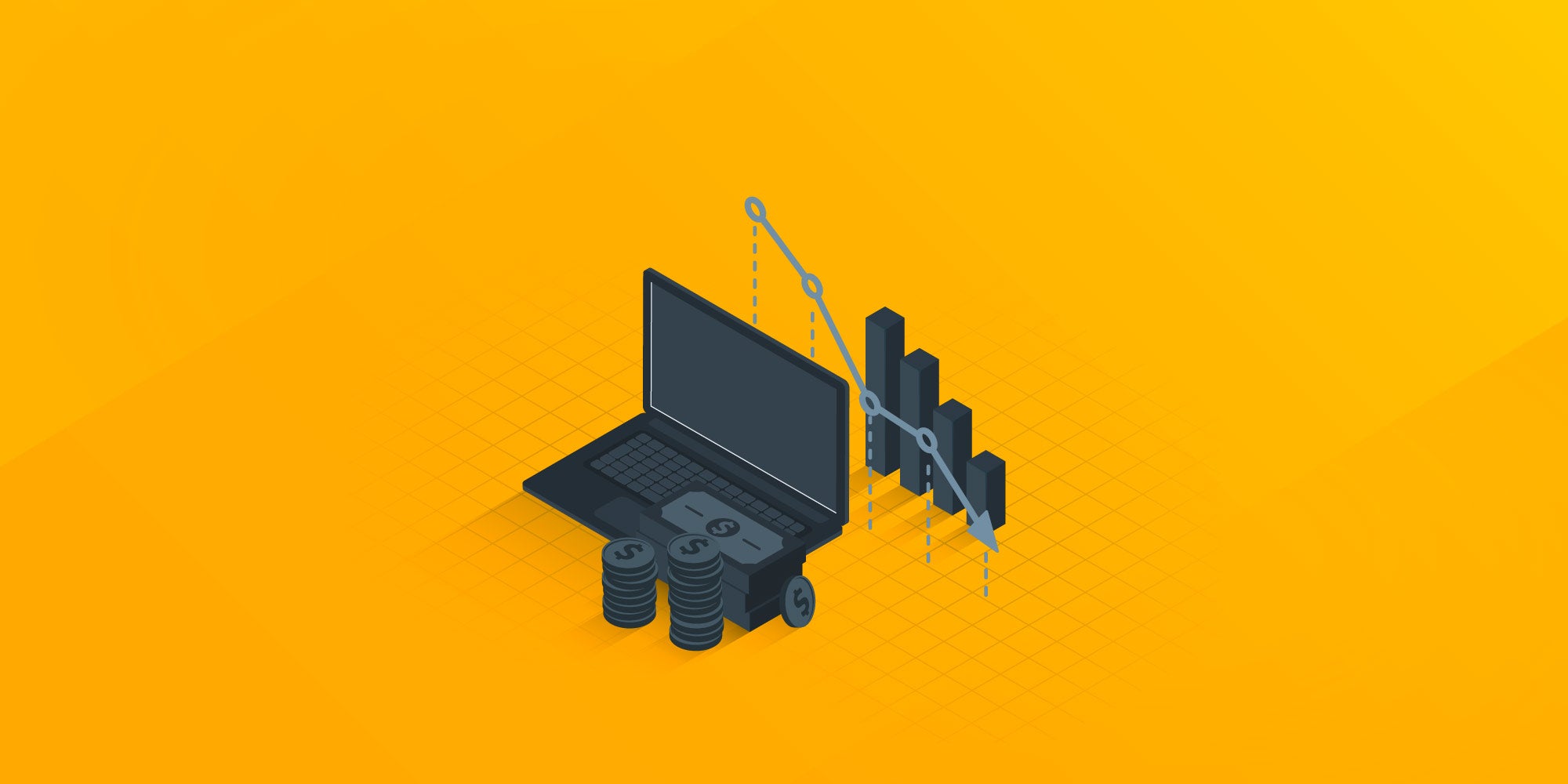Device depreciation calculator: How to accurately track IT asset value
 Zachary Trudeau
Zachary Trudeau
Every device in your IT inventory, from desktop computers to mobile phones, loses value over time. This reduction, known as asset depreciation, occurs as equipment experiences wear and tear, technological advancements, and market shifts that make newer models more efficient or affordable.
Understanding how devices depreciate helps IT and finance teams make smarter decisions about budgeting, replacements, and resale. Without tracking depreciation, it’s easy to overestimate the book value of aging hardware or miss the right window for upgrades.
A device depreciation calculator simplifies this process by estimating how much value each asset loses during its useful life. By inputting basic details, such as the initial purchase price, depreciation rate, and salvage value, IT managers can calculate depreciation using various methods, including straight-line depreciation, declining balance depreciation, and double-declining balance depreciation.
Key takeaways
-
A device depreciation calculator helps businesses estimate how much value IT assets lose over time based on initial cost, useful life, and depreciation method.
-
The most common depreciation methods: straight line, declining balance, double declining balance, and production-based, each affect how depreciation expenses are calculated and reported.
-
Tracking asset depreciation improves budgeting, compliance, and lifecycle planning, helping IT managers decide when to replace, resell, or redeploy equipment efficiently.
What is asset depreciation?
.jpg?width=600&height=300&name=device%20depreciation%20calculator%20(1).jpg)
Asset depreciation refers to the gradual decrease in an asset’s value over time, resulting from wear and tear, technological advancements, or changing market conditions. In simple terms, it reflects how much of an asset’s initial cost has been “used up” as it ages and provides less utility to the business.
For example, when a company buys a desktop computer for $1,200, that amount isn’t recorded as a one-time expense. Instead, it’s spread out across several years as the computer depreciates, representing the portion of its value consumed each fiscal year.
Depreciation helps businesses estimate an asset’s book value (its accounting worth) and actual cash value (its resale potential). By tracking these changes, IT and finance teams can make smarter decisions about device replacement, resale, and budget allocation.
Common depreciation methods include straight line, declining balance, double declining balance, and production-based approaches. The choice of method depends on how quickly the asset loses value and its contribution to daily operations.
Overview of depreciation methods
.jpg?width=600&height=300&name=ship%20a%20computer%20or%20laptop%20(1).jpg)
When calculating device depreciation, the method you choose directly affects how depreciation expenses appear on your financial statements. Each depreciation method offers a different way to measure the reduction in value of an asset over its useful life, based on how that asset delivers value to the business.
Straight line depreciation
The straight line method is the simplest and most widely used approach. It spreads the initial cost of an asset evenly across its useful life, providing a consistent annual depreciation amount.
This method works best for IT assets like desktop computers or monitors that lose value steadily rather than sharply. Because the depreciation expense remains the same each year, it makes forecasting and budgeting easier.
Formula:
Annual Depreciation = Initial Cost − Salvage Value ÷ Useful Life
Declining balance depreciation
The declining balance method accelerates depreciation, assigning a higher expense in the first few years when the asset’s performance is at its peak. It applies a depreciation rate to the asset’s book value at the beginning of each fiscal year, resulting in a decreasing expense over time.
This approach better reflects how fast-moving technology like laptops, smartphones, and tablets depreciate faster in the early years due to wear and tear and technological advancements.
Formula:
Annual Depreciation = Book Value at Beginning of Year × Depreciation Rate
Double declining balance depreciation
The double declining balance method is a more aggressive version of the declining balance approach. It uses a depreciation factor of 2, effectively doubling the straight-line depreciation rate.
This method is ideal for assets that lose more value early on, such as computers and mobile devices. While it increases depreciation expenses in the first years, it results in a lower book value and reduced expenses later in the asset’s life.
Formula:
Annual Depreciation = Book Value at Beginning of Year × (2 ÷ Useful Life)
Production depreciation method
The production depreciation method, also called the units of production method, calculates depreciation based on usage rather than time. It’s especially useful for assets whose value depends on the amount of work they perform, such as servers, manufacturing equipment, or testing devices.
Instead of spreading cost evenly over years, this method ties depreciation expenses directly to the number of units produced, hours used, or other measurable output. This makes it ideal for companies that want a depreciation rate aligned with actual asset utilization.
Formula:
Depreciation per Unit = Initial Cost − Salvage Value ÷ Total Units Expected to Produce
Then,
Depreciation Expense = Depreciation per Unit × Units Produced in the Period
Choosing the right method
The best method depends on your asset type, business model, and replacement strategy.
-
Straight line depreciation: predictable, ideal for long-term assets.
-
Declining balance: better for tech assets with rapid obsolescence.
-
Double declining balance: suitable for high-value IT equipment that depreciates quickly.
- Production method: Perfect for usage-based assets like servers or testing equipment.
Using a device depreciation calculator helps you compare all three to identify which method aligns best with your asset management and budgeting goals.
Calculating depreciation
.jpg?width=600&height=300&name=device%20depreciation%20calculator%20(5).jpg)
To calculate depreciation accurately, you need three main pieces of information:
-
The initial cost (or original purchase price) of the asset
-
Its useful life (how long it’s expected to function before replacement)
-
The depreciation method you’ll use
Some methods, like straight line depreciation, use a consistent expense each year. Others, such as the declining balance or double declining balance method, calculate a higher depreciation expense early in the asset’s life and taper off over time.
A device depreciation calculator simplifies this process by handling all the calculations for you. You simply input the initial purchase price, salvage value, and useful life, then select the desired depreciation method. The calculator instantly provides:
-
Annual depreciation
-
Depreciated value after each year
-
Book value of the asset over its lifecycle
Example Calculation
Let’s say a desktop computer was purchased for $1,200, has a salvage value of $200, and a useful life of 3 years.
-
Using the straight line method, annual depreciation = ($1,200 – $200) / 3 = $333.33 per year.
-
Under the double declining balance method, depreciation in the first year would be (2 ÷ 3) × $1,200 = $800, with subsequent years calculated based on the book value after each deduction.
By comparing results from different depreciation methods, you can determine whether it’s better to depreciate slower for long-term assets or more quickly for equipment with a shorter lifecycle, such as laptops or mobile devices.
Tip: For enterprise environments, integrating a depreciation calculator with your IT asset management system ensures that values update automatically as devices age, improving both budget forecasting and replacement planning.
Straight line depreciation method
The straight line depreciation method is the most commonly used and straightforward approach for calculating depreciation expenses. It spreads an asset’s initial cost evenly over its useful life, producing a consistent annual depreciation amount each year.
How it works
This method assumes that an asset loses value at a steady rate due to normal wear and tear rather than sudden declines. It’s widely used for IT equipment, such as desktop computers, monitors, and office devices, which maintain steady performance throughout most of their lifespan.
For example, if a computer costs $1,500, has a salvage value of $300, and a useful life of 4 years:
($1,500−$300) ÷ 4 = $300 annual depreciation
Each year, $300 is recorded as a depreciation expense until the asset reaches its depreciated value or salvage value at the end of its lifecycle.
Benefits of the straight line method
-
Consistency: Produces predictable depreciation expenses, simplifying budgeting and reporting.
-
Clarity: Provides a transparent view of book value over time.
-
Ease of Use: Simple to apply across multiple assets with similar useful lives or purchase prices.
Because it’s predictable and easy to automate, the straight line method is ideal for tracking large IT inventories or for organizations with standard hardware refresh cycles.
When to use it
The straight line approach works best for assets that depreciate slower and maintain steady performance, like monitors, network equipment, or office desktops. For fast-changing assets like laptops or mobile devices, methods such as declining balance or double declining balance depreciation may better reflect real-world value changes.
Declining balance depreciation
The declining balance depreciation method is an accelerated approach that records higher depreciation expenses during the early years of an asset’s useful life. This reflects how IT equipment, like laptops, mobile devices, and servers, loses more value when new due to wear and tear and technological advancements.
Unlike the straight-line method, which spreads costs evenly over time, declining balance depreciation applies a fixed depreciation rate to the asset’s book value at the start of each year. This results in a gradually decreasing depreciation expense as the asset ages.
How it works
The declining balance method uses a consistent depreciation rate that’s multiplied by the book value of the asset each fiscal year. Because the rate is applied to a smaller remaining value every period, depreciation expenses reduce over time—creating a curve that mirrors real-world value loss.
For example, if a desktop computer costs $1,200, has a useful life of 3 years, and a depreciation rate of 40%:
-
Year 1 depreciation = 40% × $1,200 = $480
-
Year 2 depreciation = 40% × $720 = $288
-
Year 3 depreciation = 40% × $432 = $173 (adjusted to reach salvage value)
By applying the same depreciation rate each year, this method creates a natural slowdown in expense recognition as the asset’s book value decreases.
Benefits of the declining balance method
-
Realistic value curve: Reflects how devices lose value faster in early years, especially for fast-evolving tech like laptops and phones.
-
Tax efficiency: Allows higher depreciation early on, which can help offset taxable income for businesses investing in new equipment.
-
Better asset planning: Aligns depreciation schedules with actual usage and performance decline over time.
When to use it
The declining balance method is best for IT assets that quickly become outdated or experience steep early value reduction, for example, laptops, tablets, and mobile phones. It’s ideal for organizations that regularly refresh hardware or want to match depreciation expenses with the period when the asset delivers the most utility.
For devices that maintain consistent performance or depreciate slower, such as monitors or networking equipment, the straight-line method may be more appropriate.
Double declining balance depreciation
The double declining balance method (DDB) is one of the most commonly used accelerated depreciation methods. It allows you to write off a larger portion of an asset’s value during the early years of ownership, a period when the asset’s productivity is typically highest and its market value declines fastest.
Unlike straight-line depreciation, which allocates the same expense each year, the double declining balance depreciation method doubles the depreciation rate applied to the asset’s book value at the start of each fiscal year.
How it works
The DDB method applies a depreciation factor of 2.
This results in higher depreciation expenses in the first year and progressively smaller amounts as the asset ages. Because depreciation is calculated on the remaining book value, the depreciated value never falls below the salvage value.
Example
Suppose a laptop costs $1,500 with a useful life of 3 years and a salvage value of $300.
-
Straight line depreciation rate = 1 ÷ 3 = 33.33%
-
Double declining rate = 2 × 33.33% = 66.67%
Year 1 depreciation = 66.67% × $1,500 = $1,000
Year 2 depreciation = 66.67% × $500 (book value) = $333.33
Year 3 depreciation is adjusted to bring the book value down to the salvage value ($300).
This method provides a more realistic reflection of how technology assets, such as computers, servers, and phones, lose more value early in their lifecycle due to wear and tear and technological advancements.
Why it matters for IT teams
For IT and finance leaders, the double declining balance method helps align depreciation schedules with actual usage and obsolescence rates. This makes it easier to plan hardware refresh cycles and calculate the replacement cash value or actual cash value when selling or replacing old equipment.
Using a device depreciation calculator automates these steps, ensuring accurate depreciation calculations and helping teams avoid manual errors that can affect financial reporting.
Production depreciation method
.jpg?width=600&height=300&name=device%20depreciation%20calculator%20(3).jpg)
The production depreciation method, also known as the units of production method, calculates depreciation expenses based on how much an asset is used rather than how much time passes. Instead of spreading cost evenly over years, it ties depreciation to units produced, hours used, or another measurable output.
This method is especially useful for businesses that rely on hardware-intensive operations, such as manufacturing, server-based workloads, or testing labs. For example, if a group of desktop computers is primarily used to render video or process data, their value decreases faster as their production output increases.
How it works
This method helps tie depreciation expenses directly to the revenue the asset generates, offering a more accurate reflection of actual wear and tear or usage intensity.
Example
Imagine a computer server that costs $12,000 with a salvage value of $2,000 and an expected workload of 100,000 computation hours.
If it runs for 30,000 hours in the first year:
Depreciation Expense = (12,000 − 2,000 / 100,000) × 30,000 = $3,000
As usage slows in later years, depreciation expenses decrease accordingly, giving IT teams a more dynamic and usage-based view of an asset’s declining balance.
Why it matters for IT teams
This approach benefits IT managers and CTOs overseeing servers, network equipment, or production devices where output or usage can be measured. It also helps align equipment depreciation with business activity levels, ensuring financial accuracy during busy and slow periods alike.
A device depreciation calculator with a production method option can automatically adjust annual depreciation based on the units produced or usage data provided, saving time and improving asset management accuracy.
Depreciation rate and salvage value
.jpg?width=600&height=300&name=device%20depreciation%20calculator%20(6).jpg)
Two of the most important factors in calculating depreciation are the depreciation rate and the salvage value. These determine how much of an asset’s initial cost can be written off each year and what remains at the end of its useful life.
Depreciation rate
The depreciation rate represents the percentage of an asset’s value that is depreciated annually. This rate depends on the depreciation method used and the asset’s useful life. For instance:
-
Under the straight line method, the depreciation rate is calculated as 1 ÷ useful life.
-
In the double declining balance method, the rate is doubled (for example, if an asset’s life is 4 years, the straight line rate is 25%, and the double declining rate is 50%).
Choosing the right depreciation rate ensures that your financial statements accurately reflect the wear and tear, technological obsolescence, and changes in market value over time.
Salvage Value
The salvage value (also called residual value) is the estimated amount you can recover when selling or retiring an asset after its useful life. It represents the depreciated value left once all depreciation expenses have been applied.
For example, if a desktop computer is purchased for $1,200 and has a salvage value of $200, then the total depreciable amount is $1,000, which is the portion that will be expensed over its life.
Formula:
Depreciation Base = Initial Cost − Salvage Value
Determining an accurate salvage value helps avoid overstating or understating book value, which can affect business decisions such as reselling, replacing, or retiring assets.
Why these factors matter
For IT and operations teams, understanding both the depreciation rate and salvage value provides a clear picture of when assets are approaching the end of their lifecycle, and when replacement budgets should be allocated.
A device depreciation calculator combines these inputs to produce a precise estimate of annual depreciation, actual cash value, and replacement cash value, enabling better asset lifecycle planning and financial forecasting.
Asset depreciation calculator benefits
| Depreciation Method | Formula |
|---|---|
| Straight Line | |
| Declining Balance | |
| Double Declining Balance | |
| Production (Units of Production) |
A device depreciation calculator is an essential tool for IT and finance leaders managing large inventories of computers, phones, and other equipment. It automates complex depreciation calculations, helping teams maintain accurate financial records and plan hardware refresh cycles with confidence.
Simplifies complex calculations
Instead of manually applying formulas for each depreciation method, the asset depreciation calculator handles everything automatically. It uses your provided initial cost, useful life, salvage value, and depreciation rate to calculate annual depreciation, book value, and the depreciated value of each asset.
This removes guesswork, minimizes errors, and saves significant time during each fiscal year reporting cycle.
Compares multiple depreciation methods
The calculator supports various depreciation methods, including straight line, declining balance, double declining balance, and the production depreciation method.
By comparing results side by side, businesses can determine whether to depreciate slower or faster based on how quickly assets lose value due to wear and tear or technological advancements.
Enhances budget and replacement planning
Accurate depreciation tracking helps IT teams identify when devices reach their replacement cash value and should be retired, resold, or recycled. This proactive approach prevents unplanned expenses and aligns asset replacement with business goals.
When integrated into an IT Asset Management (ITAM) platform, the calculator can even adjust book values automatically as devices age, improving both visibility and financial accuracy.
Ensures compliance and audit readiness
Automated depreciation tracking also supports compliance with accounting standards like GAAP and IFRS, which require consistent and traceable depreciation reporting. Having a clear record of depreciation expenses and asset costs ensures that businesses remain audit-ready and can justify all recorded values.
Drives data-driven decision making
Ultimately, using an asset depreciation calculator transforms how IT and finance teams make equipment decisions. Instead of relying on estimates, they can base choices on depreciated value, resale potential, and market trends, improving both cost efficiency and sustainability.
Book value and depreciation
.jpg?width=600&height=300&name=device%20depreciation%20calculator%20(2).jpg)
The book value of an asset represents its original purchase price minus the accumulated depreciation recorded over time. It’s a key measure for understanding how much an asset is worth on the company’s balance sheet at any point in its lifecycle.
Understanding book value
When a company purchases a desktop computer for $1,200, that cost becomes part of its asset cost. Over the years, as the computer experiences wear and tear and technological decline, depreciation expenses reduce its book value.
If the asset depreciates by $400 each year using the straight line method, its book value after the first year would be $800, after the second year $400, and by the third year, it reaches its salvage value.
This calculation helps businesses determine the actual cash value of equipment compared to its replacement cash value, ensuring that financial records accurately represent the device’s depreciated value rather than its outdated purchase price.
Why book value matters
For IT and finance teams, understanding book value is essential for:
-
Planning replacements for aging assets
-
Estimating resale or recovery value for retired equipment
-
Ensuring accurate accounting for audits or asset transfers
A clear grasp of book value also supports better timing in asset disposal and reinvestment decisions, especially when market trends or technological advancements accelerate depreciation.
How a calculator helps
A device depreciation calculator automatically tracks changes in book value by applying the selected depreciation method and depreciation rate each fiscal year.
This ensures every asset’s value is always up to date, helping decision-makers balance financial accuracy with practical asset management.
Seven factors affecting depreciation
.jpg?width=600&height=300&name=device%20depreciation%20calculator%20(4).jpg)
The rate and pattern of depreciation depend on multiple factors beyond just asset cost and useful life. For IT teams, understanding these variables helps predict how quickly devices lose value and when to plan replacements or budget adjustments.
1. Type of asset
Different asset categories depreciate at different rates. A desktop computer or server may hold its book value longer than a laptop or mobile phone, which typically experience faster wear and tear due to mobility and frequent use.
2. Useful life
The useful life of a device, its expected operational period before becoming obsolete, affects both the depreciation rate and total depreciation expenses. Businesses often estimate this period based on manufacturer guidelines, technological advancements, or internal replacement policies.
3. Depreciation method
The chosen depreciation method directly determines how value is reduced over time.
-
The straight line method assumes a steady loss of value.
-
The declining balance and double declining balance methods accelerate depreciation early on.
-
The production depreciation method ties depreciation to output or usage.
Each approach produces different depreciation calculations and book values across the same period.
4. Wear and tear
Everyday use, hardware stress, or environmental factors (like heat, dust, or poor ventilation) increase physical degradation, reducing both performance and resale value. Improper maintenance or misuse can also shorten a device’s lifespan and cause it to depreciate faster.
5. Technological advancements
Rapid innovation leads to market trends where newer models outperform existing ones. Even if a device is still functional, its market value and replacement cash value decrease when superior technology becomes available.
6. Market conditions
External economic and market trends, such as supply chain fluctuations or shifts in demand for hardware, also affect the depreciated value. A device may retain more value if its model becomes scarce, or lose value faster when market saturation occurs.
7. Maintenance and usage patterns
Consistent maintenance and moderate usage can extend an asset’s useful life, allowing it to depreciate more slowly. Tracking usage through an IT asset management system ensures accurate projections of depreciation rate and helps forecast replacement timelines.
Accurately estimating these factors helps businesses align depreciation schedules with the real-world performance of their assets, thereby minimizing financial discrepancies and supporting smarter hardware investments.
A device depreciation calculator can integrate all these factors to provide precise, automatically adjusted results each fiscal year, keeping financial records and operational planning in sync.
Why companies choose GroWrk for complete IT Asset Lifecycle Management
Managing device depreciation is just one part of maintaining control over a global IT ecosystem. GroWrk enables companies to go beyond depreciation tracking, offering a single, end-to-end platform to procure, deploy, retrieve, and recycle IT assets anywhere in the world.
Our platform combines automation, visibility, and security to help IT managers, procurement teams, and CTOs manage the entire device lifecycle efficiently, from the moment a device is purchased to its secure end-of-life disposal.
With GroWrk, you can:
-
Manage every stage of the IT asset lifecycle from one platform. Procure, configure, ship, retrieve, and retire devices seamlessly across 150+ countries, reducing overhead and eliminating regional vendor complexity.
-
Automate depreciation tracking and inventory reporting. Get full visibility into your IT assets’ book value, depreciated value, and replacement cost, with real-time analytics for better budgeting and audit readiness.
-
Simplify procurement and configuration. Order and pre-configure devices using zero-touch deployment, MDM enrollment, and identity management integration for instant employee readiness.
-
Streamline global onboarding and offboarding. Ensure every distributed employee receives their device on day one, and that all equipment is securely retrieved, wiped, and stored when they leave.
-
Leverage powerful integrations. Connect GroWrk with your existing IT and HR tools, like ServiceNow, Okta, JAMF, or Intune, to sync asset data, automate workflows, and eliminate manual steps.
-
Enhance compliance and security. Protect devices with full MDM enrollment, remote lock/wipe capabilities, and data sanitization for certified end-of-life handling.
-
Access flexible pricing and service options. Choose between A La Carte, Flex, or Fully Managed models to match your operational scale, with transparent per-device pricing and no hidden fees.
-
Get global support with local expertise. Each customer is backed by a dedicated Customer Success Manager and 24/7 AI-driven support, ensuring consistent SLAs and rapid issue resolution worldwide.
-
Drive sustainability initiatives. Reuse or recycle your inventory responsibly through certified recycling and donation programs, turning lifecycle management into a sustainability advantage.
GroWrk isn’t just another logistics vendor, it’s your strategic IT operations partner. From cost visibility to secure global retrieval, GroWrk empowers you to make data-driven IT decisions that reduce waste, increase efficiency, and support your business’s global growth.
Request a demo today!
FAQs
What is a device depreciation calculator?
A device depreciation calculator is a tool that helps businesses estimate how much value their equipment loses over time. By entering the initial cost, useful life, depreciation rate, and salvage value, users can calculate annual depreciation and determine the book value or depreciated value of IT assets.
What are the main depreciation methods for IT assets?
The most common depreciation methods include:
-
Straight line depreciation: spreads the asset’s cost evenly across its useful life.
-
Declining balance depreciation: applies a fixed rate to the remaining book value each year.
-
Double declining balance depreciation: doubles the straight line rate for faster early-year depreciation.
-
Production depreciation method: bases depreciation on usage or units produced instead of time.
Each method provides a different view of how wear and tear, technological advancements, and market trends affect value.
How do I calculate depreciation for a laptop or desktop computer?
To calculate depreciation, subtract the salvage value from the initial purchase price, then divide by the useful life (for straight line depreciation).
For example:
A $1,200 laptop with a salvage value of $200 and a useful life of 3 years will have annual depreciation of $333.33 using the straight line method.
What is the difference between straight line and declining balance depreciation?
The straight line method allocates equal depreciation each year, ideal for assets that depreciate slower and have consistent performance.
The declining balance method front-loads depreciation, useful for assets like computers and phones that lose more value early in their lifecycle due to rapid technological changes.
What is the double declining balance method used for?
The double declining balance method applies a depreciation factor of 2 to the straight line rate, making it suitable for assets that lose value quickly, such as IT devices, servers, and mobile equipment. It results in higher depreciation expenses in the early years and lower ones later.
How does salvage value affect depreciation?
The salvage value (or residual value) is what an asset is expected to be worth at the end of its useful life. A higher salvage value reduces total depreciation expenses, while a lower salvage value increases them. It’s a critical factor when calculating book value and replacement cash value.
Why is tracking depreciation important for IT asset management?
Tracking depreciation helps businesses understand the true value of their IT assets, plan replacements, and manage budgets more effectively. It also supports compliance with accounting standards such as GAAP and IFRS, and improves accuracy in financial reporting and asset recovery.
Can depreciation rates vary for different types of devices?
Yes. Laptops and phones typically depreciate faster due to frequent upgrades and technological obsolescence, while servers and networking equipment often have longer useful lives and depreciate more gradually. Choosing the right depreciation rate ensures realistic valuation.
How does a depreciation calculator support IT lifecycle management?
A depreciation calculator provides clear visibility into asset cost, depreciated value, and remaining useful life, enabling IT teams to time upgrades, manage resale or recycling, and track total lifecycle costs. When integrated with an IT asset management platform, it automates these calculations and syncs them with inventory data.
How does GroWrk help with IT asset depreciation and management?
GroWrk simplifies global IT asset management by automating every stage of the device lifecycle, from procurement to end-of-life. It centralizes asset tracking, provides real-time depreciation insights, and ensures every device is securely deployed, recovered, and recycled. With coverage in 150+ countries, GroWrk helps IT teams maintain accurate valuations, reduce costs, and make data-driven decisions at scale.


_1_11zon.jpg)




